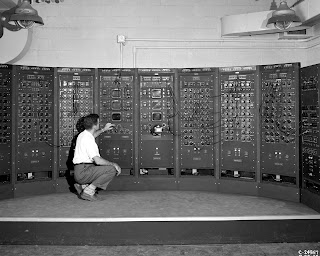US and Japan in the Tech Mix
 The glittering electronics displays in Tokyo’s Akihabara district provides the backdrop to one of the world’s most highly evolved technology sectors. The massive logos of Sony, Fujitsu, and a legion of other Japanese tech companies are displayed colorfully across the city streets. This is the imagery that many Americans have become accustomed to when picturing Japan from the outside. They think of the high-tech world that the Japanese are famous for, constantly innovating in both practical and un-conventional arenas.
The glittering electronics displays in Tokyo’s Akihabara district provides the backdrop to one of the world’s most highly evolved technology sectors. The massive logos of Sony, Fujitsu, and a legion of other Japanese tech companies are displayed colorfully across the city streets. This is the imagery that many Americans have become accustomed to when picturing Japan from the outside. They think of the high-tech world that the Japanese are famous for, constantly innovating in both practical and un-conventional arenas.
Today, as the global economy further intertwines, the US and Japanese technology sectors have become curiously symbiotic. We often see new technologies hitting the Japanese market first, and if successful, making its way to American consumers. U.S. software and hardware also often finds its way into Akihabara storefront displays after a successful domestic debut. Although this two-way tech channel often works out in the favor of both markets, it sometimes proves difficult for each country’s technology to penetrate the complex cultural and economic barriers.
I’d like to take an opportunity to examine several recent examples of successful and unsuccessful cross-pollination between the Japanese and American technology industries. If I leave anything out, feel free to chirp in with your own comments!
Prius: The Toyota Prius provides an incredible story of a product that perhaps will end up doing better in a foreign market than it did in its originator country. Especially in California and the tech-hotbed of Silicon Valley, the Prius has become a symbol of Eco-conscious living, cutting edge technology and youthful thinking.
Just take a drive to Google’s Mountain View campus, where dozens of Prius cars are plugged into designated ‘charge’ spots. Even Sergey Brin, one of the search giant’s founders, drives a Prius. This is an example of a technology making the overseas transition with fluidity and efficiency.
iPhone: The iPhone is a prime example of a genius product that has sold like hotcakes in the US and Europe, but failed to crack the Japanese market. Many attribute the iPhone’s poor sales to the Japanese consumer’s selectivity in mobile phone choice.
Japan is often pushing the mobile boundaries with high-tech video and voice features that the iPhone lacks. The iPhone also is a high-price monthly option compared to many of the other Japanese carriers.
Facebook: Facebook is example of something lost in translation between Silicon Valley and Tokyo. Japan’s most popular social network remains Mixi, which holds over 80% of Japanese social network users. Although Facebook was able to gain a large portion of European users, Japanese social networkers remain loyal to similar previously standing sites.
There are a number of complex cultural differences that also make Facebook a bad option for Japanese users. For example, many Japanese prefer to register an online account under a pseudonym or nick-name, rather than a real first and last name as Facebook requires.
Cisco Hardware: Cisco Systems, the Silicon Valley network hardware giant, has made leaps and bounds in providing network infrastructure solutions for Japanese companies. Over the past several years, Cisco has steadily been expanding in the Japanese high tech arenas through video collaboration and unified computing solutions. Japanese companies are fast adopting Cisco’s new ‘Solution-Centric’ distribution model that will accelerate their ability for network use through integrated cisco hardware.
If Cisco continues on its current path in Japan, it will definitely prove to be a US – Japanese technology.